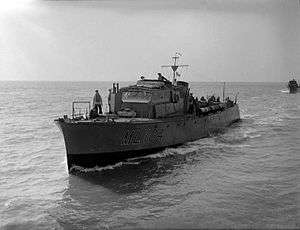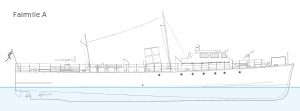Fairmile A motor launch
The Fairmile A motor launch was a type of motor launch designed by Fairmile Marine for the Royal Navy.
 The Fairmile A motor launch ML104 carrying mines in 1941 at Dover, England | |
| Class overview | |
|---|---|
| Name: | Fairmile A motor launch |
| Succeeded by: | Fairmile B motor launch |
| Completed: | 12, numbered from ML100 to ML111 |
| General characteristics | |
| Displacement: | 57 tons, not including armament and equipment |
| Length: | 110 ft (34 m) |
| Beam: | 17 ft 5 in (5.31 m) |
| Draught: |
4 ft 6 in (1.37 m) forward, 6 ft 6 in (1.98 m) aft |
| Propulsion: | 3 Hall-Scott Defender V12 petrol engines 600 hp |
| Speed: | 25 knots (46 km/h; 29 mph) at 2,200 rpm |
| Range: | 600 mi (520 nmi; 970 km) at 12 knots (22 km/h; 14 mph) |
| Complement: | 16, including 2 officers |
| Sensors and processing systems: | ASDIC |
| Armament: |
one QF 3 pounder Hotchkiss gun one pair of 0.303 in. Lewis machine guns 12 depth charges |
Development
Shortly before the Second World War the British industrialist Noel Macklin submitted to the Admiralty an innovative plan for the series production of a motor launch. The design used prefabricated parts, which allowed various small concerns, such as furniture and piano manufacturers,[1] to produce the individual components. These components could then be assembled in separate shipyards. The hull was to be made of double diagonal mahogany planking with plywood frames divided into nine watertight compartments.
The Admiralty rejected the concept, and so the prototype was built as a private venture. In July 1939, two months before the outbreak of war, the Admiralty had a change of heart and awarded Macklin a contract to build eleven further Type A Fairmiles.
Service

The first vessel (ML100) was not completed until May 1940 because of handling problems at low speeds, although the subsequent boats had all entered service by July.[2] Their role was to be anti-submarine escorts in coastal waters, but, once the better Fairmile B motor launches began to enter service in the autumn of 1940, the Type A boats were converted to minelayers.[3]
See also
References
- Mullard Heals and Parker Knoll are among those named. The subdivision of the work outside traditional boat builders was part of an agreement not to make demands on the usual suppliers to the Admiralty
- Angus Konstam, British Motor Gun Boat 1939-45 Osprey Publishing Limited 2010, ISBN 978-1-84908-077-4 (pp.12-14)
- Konstam (p.15)
- Allied Coastal Forces of World War Two, Volume I : Fairmile designs and US Submarine Chasers - by John Lambert and Al Ross - 1990, ISBN 978-0-85177-519-7
External links
| Wikimedia Commons has media related to Fairmile A Motor Launches. |